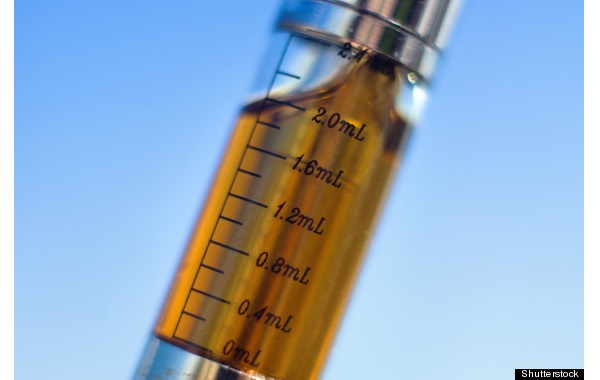This article is part 5 of the Top 20 Rebuttals to Win an E-Cigarette Debate

Most of us are now well-versed with the 2009 FDA study that found a small amount (1%) of diethylene glycol, a toxic ingredient in anti-freeze, in 1 out of 18 cartridges from just two brands of electronic cigarettes. Not one study since then has found the chemical in any cartridges or liquids, suggesting that the device in question may have been contaminated.
Key Points
- While having similar characteristics as automotive antifreeze, Propylene glycol and vegetable glycerol are not toxic.
- Only one e-cig cartridge has ever been found to contain diethylene glycol, a toxic component of automotive antifreeze.
- Many e-liquids are self-regulated under AEMSA standards to ensure quality control.
Common E-liquid Ingredients
The four ingredients used in the majority of e-liquids are propylene glycol, vegetable glycerin, GRAS flavoring and nicotine. Propylene glycol is also a component of antifreeze but only to make it less toxic if swallowed. It's actually marketed as “non-toxic antifreeze” and is used in places like home water pipes where incidental digestion may be possible.
Glycerol was also used as a component of automotive antifreeze prior to being replaced by ethylene glycol. Like propylene glycol, it is non-toxic and has the ability to withstand extreme temperatures. However, ethylene and diethylene glycol have lower freezing points so they have replaced the much safer PG and VG forms of antifreeze in applications where contamination is not a concern.
There just really isn't much of a reason for e-liquid manufacturers to use diethylene glycol, or DEG, in their mixes. Propylene glycol and vegetable glycerine both produce a smoke-like vapor when heated and are more importantly non-toxic. So why did that one sample contain DEG?
Other Applications of Deithylene Glycol
Unfortunately for smokers, diethylene glycol is used in tobacco processing. As a result, cheaper, less filtered nicotine may become contaminated with DEG. It may also be a byproduct of low-grade propylene glycol, most likely the cause with the sample found to contain trace amounts of diethylene glycol in the FDA study. The majority of e-liquid manufacturers use USP grade nicotine and propylene glycol, neither of which should contain DEG.
Diethylene glycol has also been found in many counterfeit medicines. It is far cheaper than glycerin but the consequences of substitution are deadly. China, known in the electronic cigarette market for not only being the birthplace of the e-cig but also a big manufacturer of “clone” mods and other vaping products, has been a major source of drug counterfeiting.
Just in Case
Aside from providing yet another unreasonable grounds for anti-tobacco harm reduction scare tactics, the 2009 FDA study did make it clear that the e-liquid manufacturing industry needs better quality control. Some juice makers follow the self regulations set forth by the American E-Liquid Manufacturing Standards Association. Regulation is not yet a requirement, however, so there is still a slight chance for an e-liquid to cut corners.
In the event that does occur, exactly how dangerous is DEG inhalation? In terms of tobacco use, a lethal dose would require 750,000 cigarettes to be smoked in one day. Diethylene glycol inhalation in rats caused only mild local respiratory irritation. But again, to date only one cartridge of electronic cigarette has ever been found to contain any amount of DEG, so the chances of your e-liquid containing it are slim to none.
In any event, vapers should take precautions by only buying their e-liquid from reputable vendors and manufacturers. Check ingredients on the bottle label and look for words like “USP”, “USA Made” and “SGS” for added safety measures. Obviously avoid anything that blatantly states diethylene glycol is used as an ingredient.
Anti-THR Lies
The most unfortunate result of the 2009 FDA study is not that non-lethal concentration of DEG was found in trace amounts of just one e-cig cartridge, but that Anti tobacco harm reduction activists have been spreading lies regarding the finding ever since. They say things like “E-Cigarettes contain antifreeze” or make propylene glycol out to be a dangerous component of the chemical solvent.
The truth is that while propylene glycol and glycerins do have antifreeze properties, they are non-toxic. They aren't what makes automotive antifreeze harmful if swallowed. And they are commonly used in many foods and medicines as preservatives, sweeteners and humectants.
Diethylene glycol, one of the toxic components of automotive antifreeze, is not and should not be used in the manufacturing of electronic cigarette e-liquid. It has only been found in one cartridge, on one occasion, and at a non-lethal level. There is no need to worry, or likewise spread unnecessary fear about electronic cigarettes containing any harmful ingredients used in automotive antifreeze.
Yes, they do contain ingredients with anti-freezing properties. But those agents are not toxic and are used in plenty of other applications approved for human consumption. So for now e-cig enthusiasts can keep calm and vape on!
Further reading:
- E-Cigarettes Contain Antifreeze – Stop the ANTZ
- Inhalation Exposure of Rats to Diethylene Glycol – Oxford Journals
- From China to Panama, a Trail of Poisoned Medicine – NYTimes
- Are Electronic Cigarettes Safe? – CASAA

